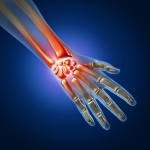Rheumatoid Vs. Osteoarthritis
What type of arthritis do I have may seem like a simple question. Though with over 100 types of known arthritis it is not always a simple answer. Osteoarthritis affects up to 40 million Americans. In contrast, rheumatoid arthritis affects roughly 1% of the population, or 2.5 million Americans.
The diagnosis of osteoarthritis is based on both clinical and x-ray findings. This differs from rheumatoid arthritis as its diagnosis depends partially on lab results and clinical findings. On the other hand, x-ray findings may be negative in the beginning of the disease and progress to joint erosion over time.
In this blog, we will define both rheumatoid arthritis and osteoarthritis. After that, we will identify the related symptoms, demographic of occurrence, and different treatment options for each type of arthritis.
Osteoarthritis

Definition
Osteoarthritis is the most common form of arthritis, and is defined as a degenerative disease of the joints. Over time this may lead to the loss in articular cartilage.
To clarify, this loss in cartilage leads to the decrease in the “cushion” of the joint. This cushion is what allows for pain free motion without friction. This friction begins the overall soft tissue and bony surface joint changes seen in osteoarthritis.
Symptoms
The symptoms of osteoarthritis differ from person to person and the specific joint affected.
Symptoms include:
- Stiffness which worsens with inactivity.
- Pain may be present in the affected joint during or after a movement.
- Soft tissue tenderness with or without swelling around the joint.
- Popping or crepitus with motion.
More often than not, symptoms develop slowly and increase with age. If the osteoarthritis is advanced, the joint can become unstable. As a result, it puts more strain on the surrounding ligaments, tendons and muscles.
Demographics
Osteoarthritis can affect anyone. Most often people may be at a higher risk due to:
- Trauma to the joint.
- General muscle weakness.
- High demands of physical labor.
- High impact competitive sports.
Obesity plays a role as well as it increases the load on the weight bearing joints, Additionally, fat cells release an inflammatory inducing protein that can damage the joint tissue. Other general risk factors include gender, aging, and genetics.
Treatments
Non-Operative
Different ways to manage pain and prevent symptoms from worsening are:
- NSAID’s and Tylenol.
- Physical therapy or home exercises.
- Weight loss.
- Corticosteroid injections.
- Viscosupplementation injections.
- Platelet Rich Plasma (PRP) injections.
Operative Treatment
It is best to discuss these options with your healthcare provider to make an informed decision, however, surgical options to be considered are:
- Arthroscopic debridement
- Joint replacements (total joint arthroplasty)
- Joint arthrodesis
- Tendon transfers are options for various hand joints
Rheumatoid Arthritis

Definition
Rheumatoid arthritis is the most common form of inflammatory arthritis. This is a systemic disease, meaning can affect multiple organ systems. In contrast to osteoarthritis, rheumatoid arthritis causes the immune system to attacking the joint and the surfaces that support our joints.
Symptoms
Rheumatoid arthritis often starts in the smaller joints and will move on to the larger joints with time. The onset can sneak up on you with painful, swollen joints. After that, one may experience a loss in flexibility and function. The swelling can involve warmth that does not easily resolve. Given the disease is systemic, some may experience fatigue and generalized uneasiness.
Demographics
Rheumatoid arthritis is an autoimmune disease that tends to affect women more than men.
Similar to osteoarthritis, it can be present at any age. However it typically occurs by middle age.
The known risk factors include a family history of RA, smoking, and obesity.
Treatment
The treatment for rheumatoid arthritis has made remarkable improvements over the last decade. To start, the mainstay of treatment is with medications known as Disease Modifying Antirheumatic Drugs (DMARDs). It’s important to correctly diagnose rheumatoid arthritis to use this class of medications. DMARDs can slow down the disease process by interfering with the immune system. In addition, use can induce remission in some cases.

Cameron Hunt Reyes, PA-C
Physician Assistant to Suzanne G. Elton, MD
Orthopedics has developed as a prime interest of mine after seeing patients suffer with joint ailments, develop depression because they can no longer golf, ski, walk their dogs, or chase their children. A combination of joint injections, physical therapy and or surgery changes their lives. As fitness is a mainstay in my life, I value the importance of normal mobility to facilitate a high quality of life.
Related Physicians
The providers at Kansas City Bone and Joint Clinic each have their own areas of specialty. Click on the providers below to read more about them.




